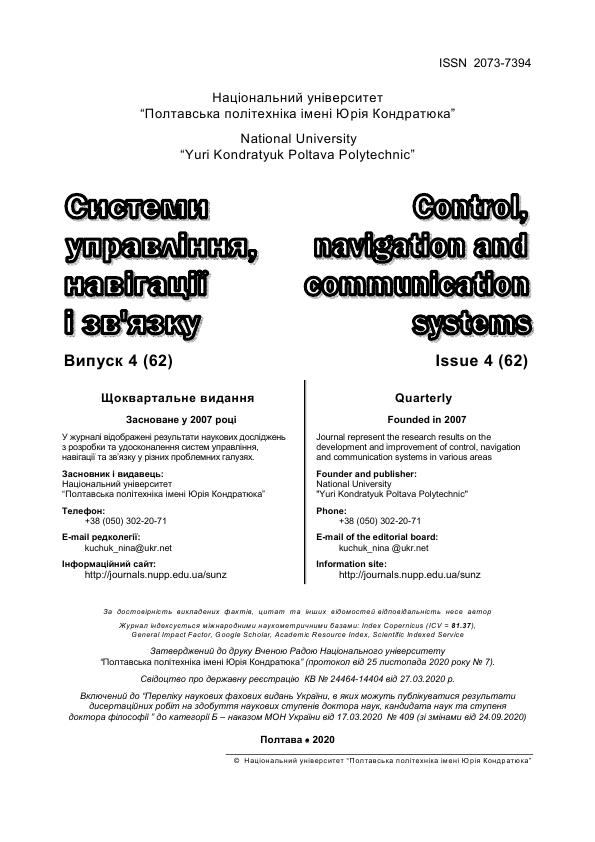МЕТОД ФОРМУВАННЯ АНСАМБЛІВ СКЛАДНИХ СИГНАЛІВ ЗБІЛЬШЕНОГО ОБ’ЄМУ НА ОСНОВІ ВИКОРИСТАННЯ ЧАСТОТНИХ СМУГ
DOI:
https://doi.org/10.26906/SUNZ.2020.4.119Ключові слова:
завада множинного доступу, відеоімпульс, ширина спектру сигналу, період слідування імпульсів, функція взаємної кореляції, база сигналу, низька взаємодія в часовій області, складний сигналАнотація
Використовуючи відомі ансамблі сигналів, побудовані на основі лінійних та нелінійних рекурентних послідовностей, важко отримати ансамблі сигналів з великими обсягами та задовільними характеристиками взаємозв'язку. Метою статті є розробка методу синтезу складних ансамблів сигналів великого обсягу шляхом ділення спектру низхідних псевдовипадкових послідовностей з низькою взаємодією в часовій області на смуги з подальшою передачею прийнятих сигналів в інший діапазон і наступні перестановки. У статті викладено результати розробки методу формування ансамблів складних сигналів збільшеного об’єму на основі використання частотних смуг із застосуванням процесу перенесення частотних елементів в область робочих частот технології LTE і подальшими перестановками. Застосування багатократної фільтрації до вихідних псевдовипадкових послідовностей з низькою взаємодією в часовій області з повторною фільтрацією отриманих сигналів та їх подальша перестановка дозволяє збільшити граничний об’єм ансамблю сигналів порівняно з існуючими ансамблями складних сигналів, які використовуються в сучасних системах радіозв’язку з кодовим розділенням каналів
Завантаження
Посилання
Setoodeh P. Fundamentals of cognitive radio / P. Setoodeh, S. Haykin. – Hoboken: John Wiley & Sons, 2017. – 207 p. DOI:10.1002/9781119405818.
Sklar B. Digital communication. Theoretical foundations and practical application / B. Sklyar. - Moscow: Williams Publishing House 2003. – 1104 p.
Arslan H. Cognitive radio, software defined radio and adaptive wireless systems / H. Arslan. – Dordrecht : Springer, 2007 453p. DOI:10.10079781402055423.
Varakin L. E. Communication systems with noise-like signals / L. E. Varakin –Moscow : Radio and communication, 1985. – 384 p.
Ipatov V. P. Spread spectrum and CDMA: Principles and applications / V. P. Ipatov – Moscow : Technosphere, 2007. – 488 p. ISBN 978-5-94836-128-4.
Iacobucci M. S. Reconfigurable radio systems: network architectures and standards / M. S. Iacobucci. – Chichester : John Wiley & Sons, 2013. – 275 p. DOI:10.1002/9781118398401.
Petrovich N. T. Communication systems with noise-like signals. / N.T. Petrovich, M.K. Razmakhnin. - Moscow: Soviet Radio, 1969. - 232p.
Semenikhin V. S.. Land mobile radio communication / V.S. Semenikhin, I.M. Pyshkyn. - Moscow: Radio and Communication, 1990 - 432 p.
Indyk S. Method of permutation of intervals, taking into accountant correlation properties of segments / S. Indyk, V. Lysechko // Control, navigation and communication system. – 2020. Issue 3 (61). – P. 128 – 130. DOI:10.26906/SUNZ.2020.3.
Indyk S. The study of ensemble properties of complex signals obtained by time interval permutation / S. Indyk, V. Lysechko // Advanced Information Systems. – 2020. – Vol. 4, No 3. – P. 85 – 88. DOI: 10.20998/2522-9052.2020.3.11.
Sloane N. J. A. The Encyclopedia of Integer Sequences, N. J. A. Sloane, S. Plouffe, Academic Press, San Diego, 1995, 587 p. ISBN 0-12-558630-2.
Grishentsev A.Y. Digital broadband systems. Part 1. Introduction to spaces and methods of signal conversion / A.Y. Grishentsev. - SPb: ITMO University, 2019.- 72 p.




